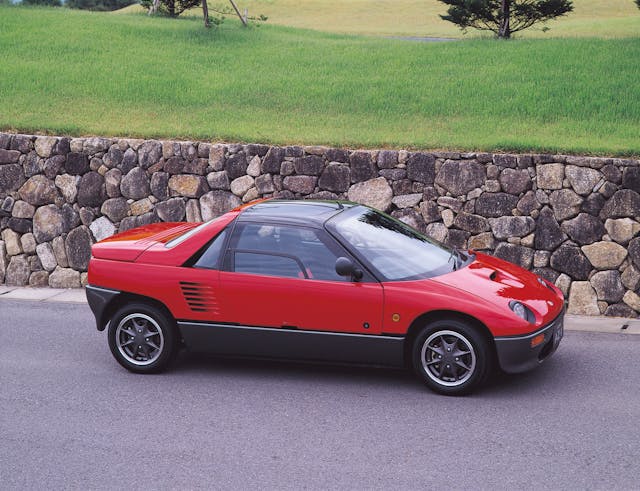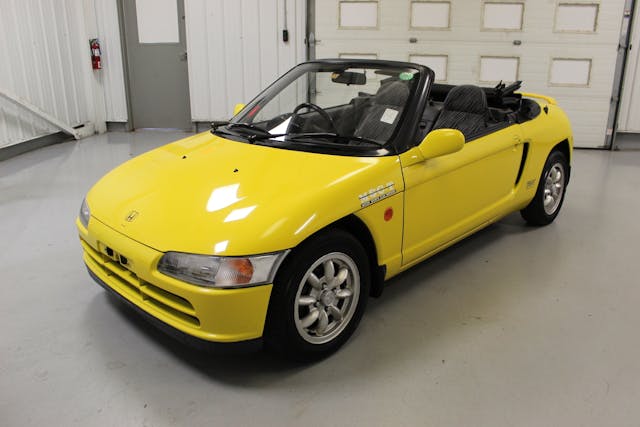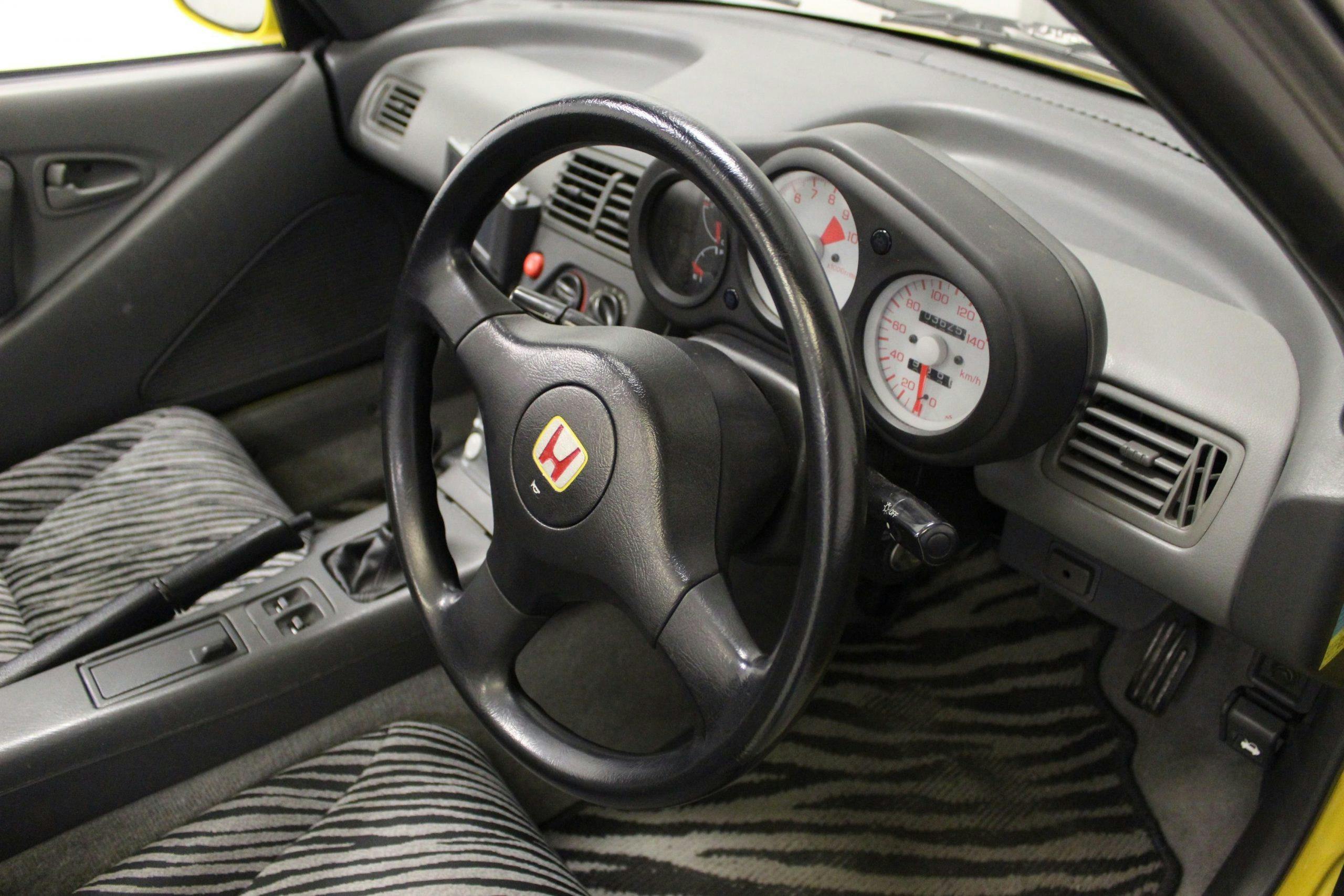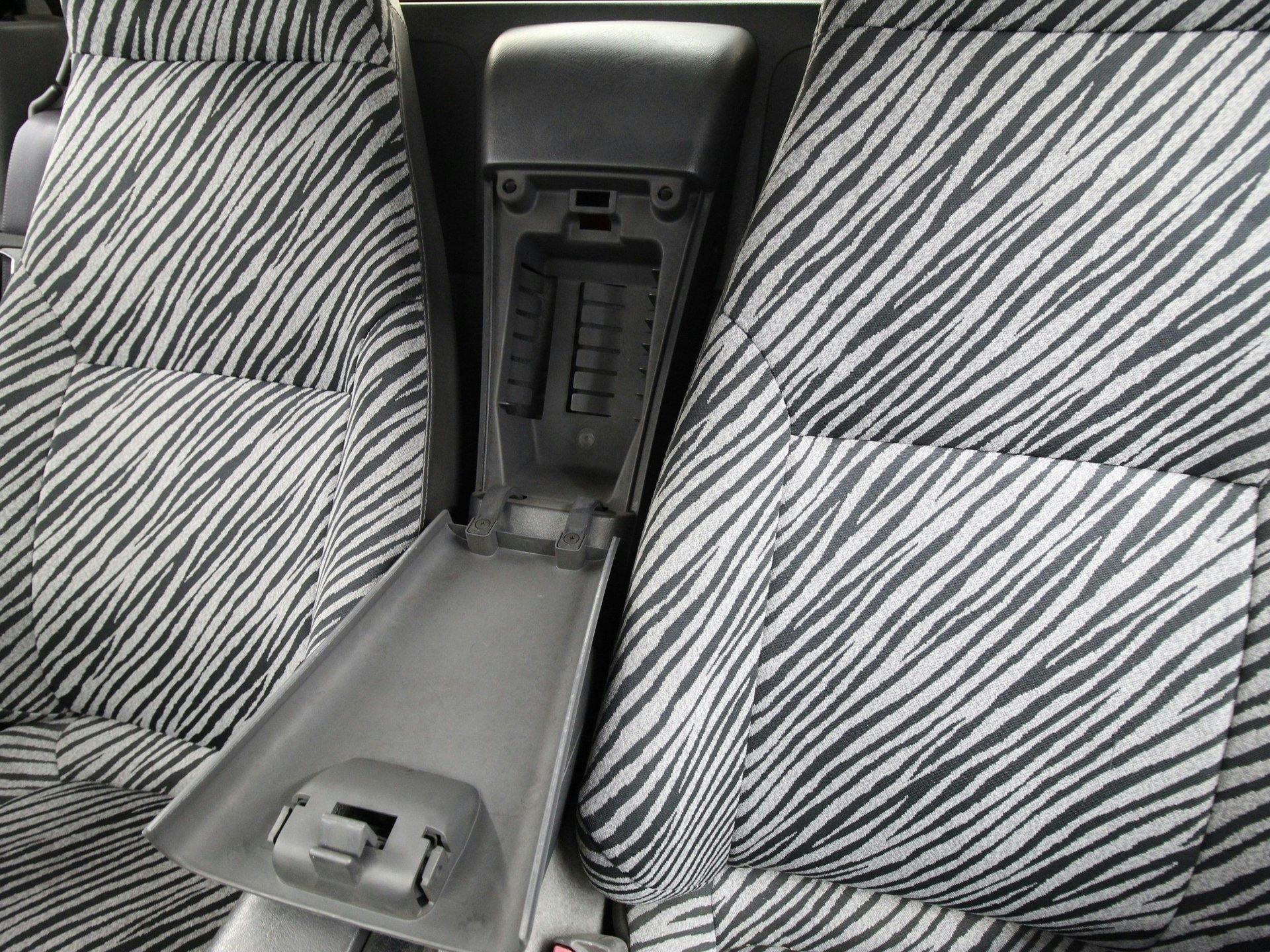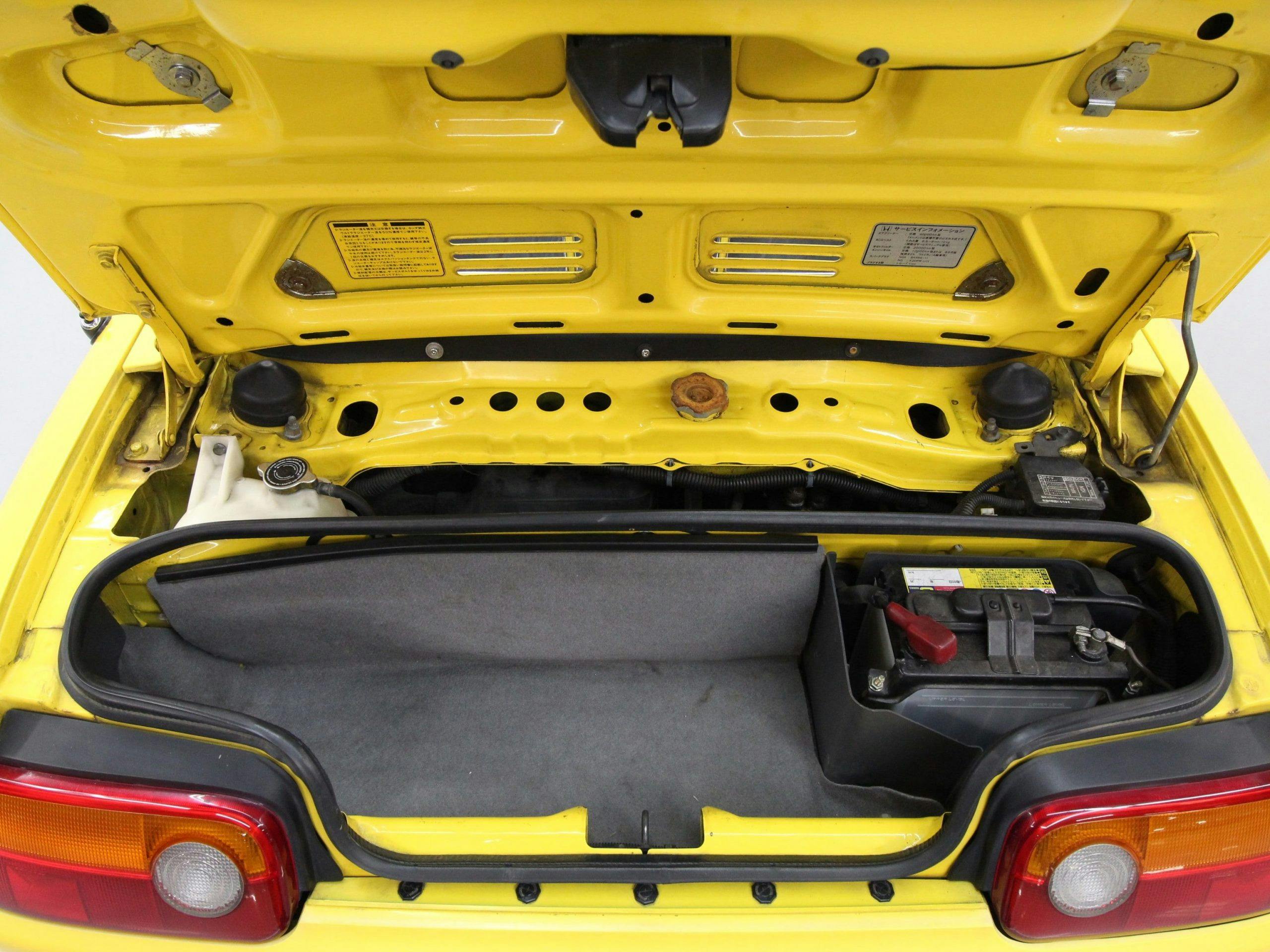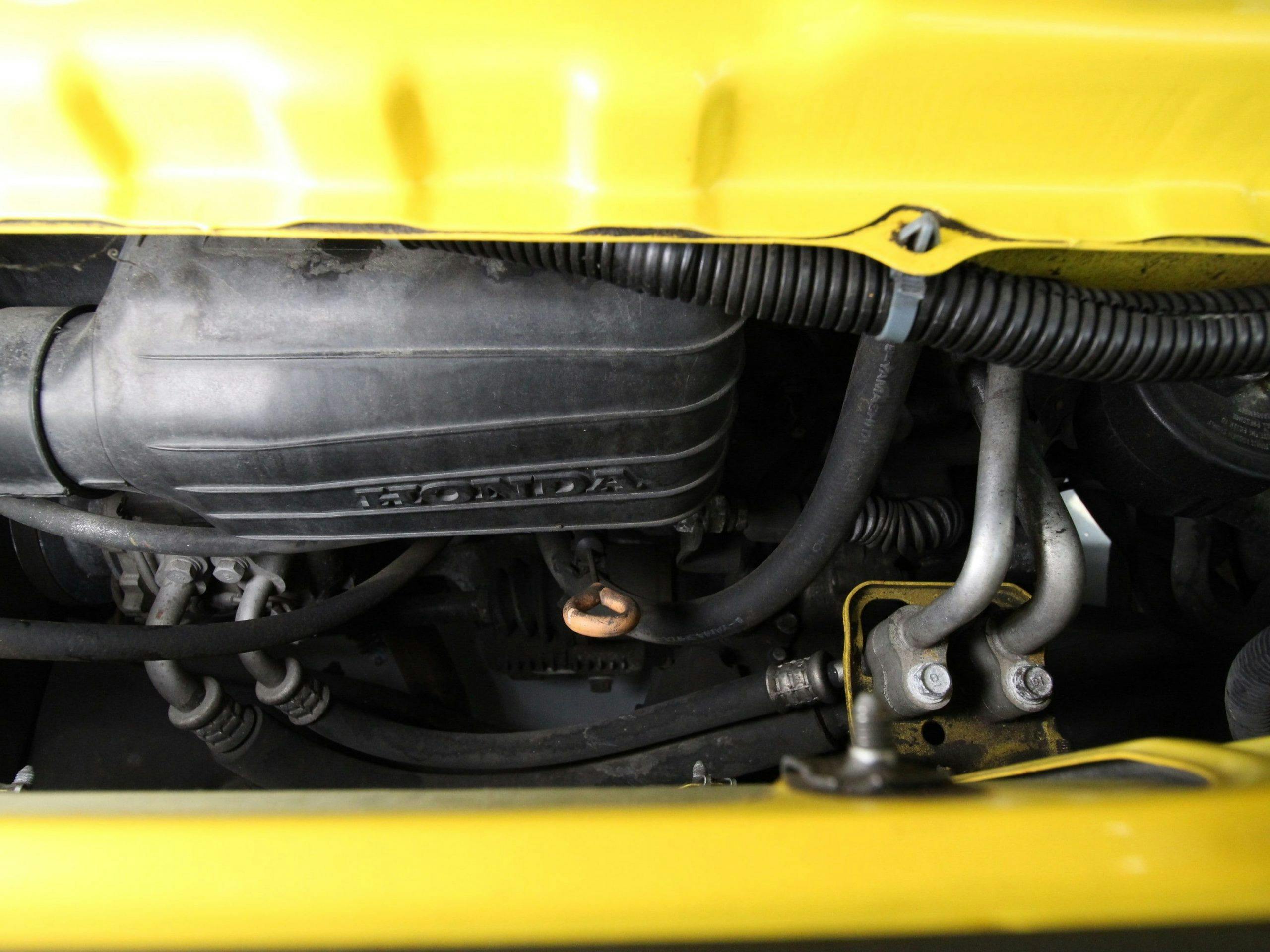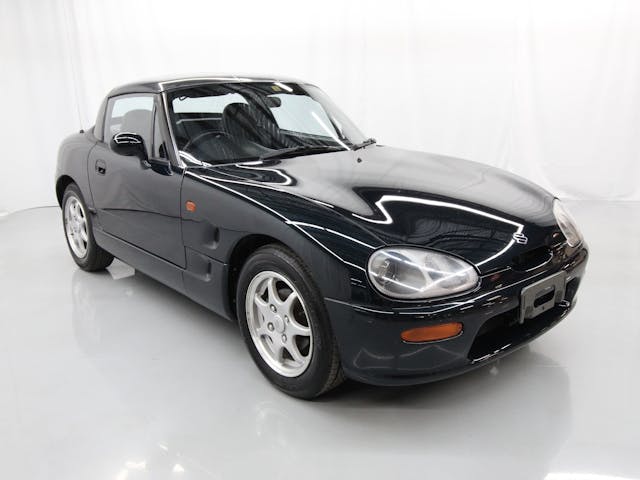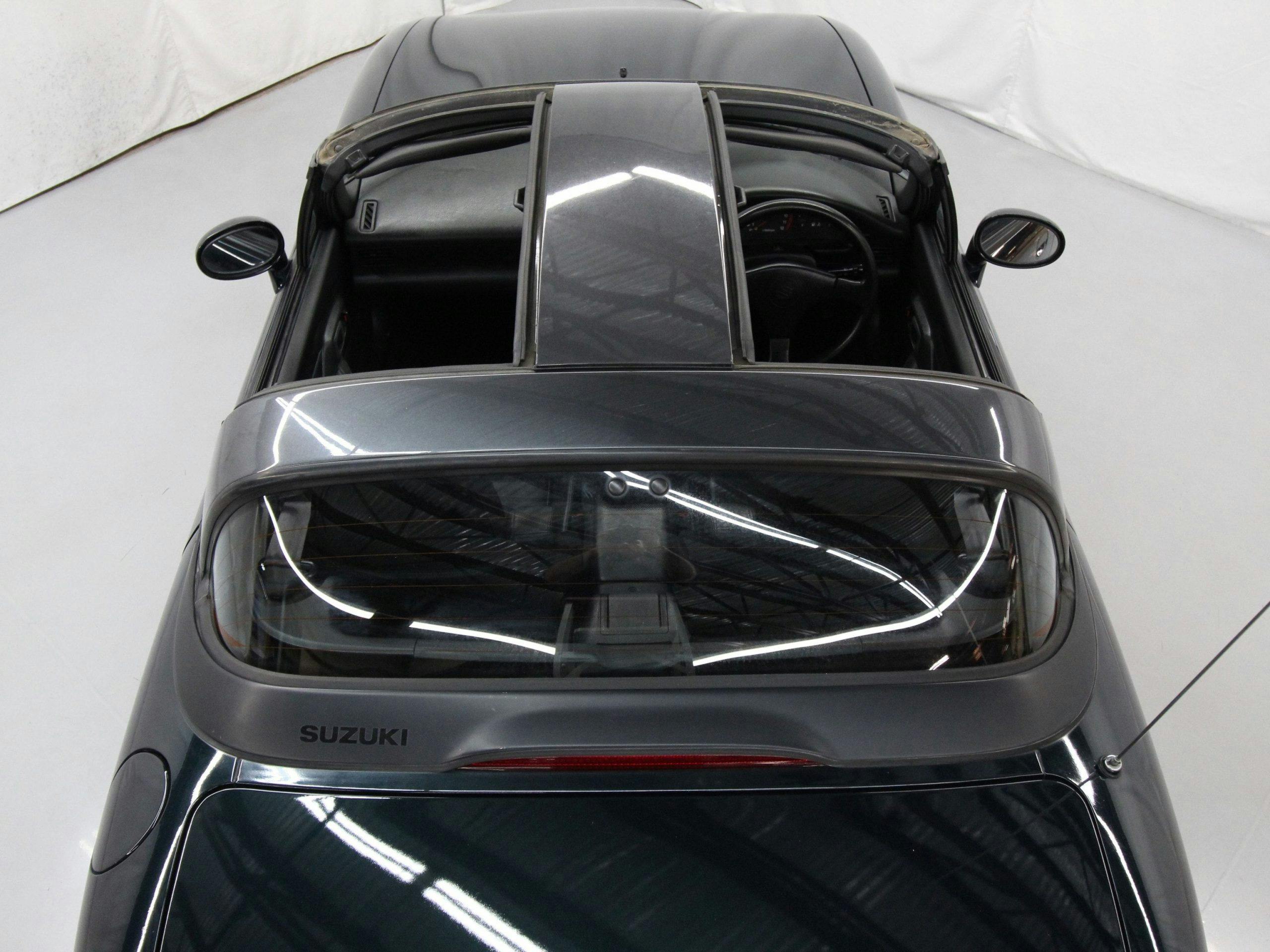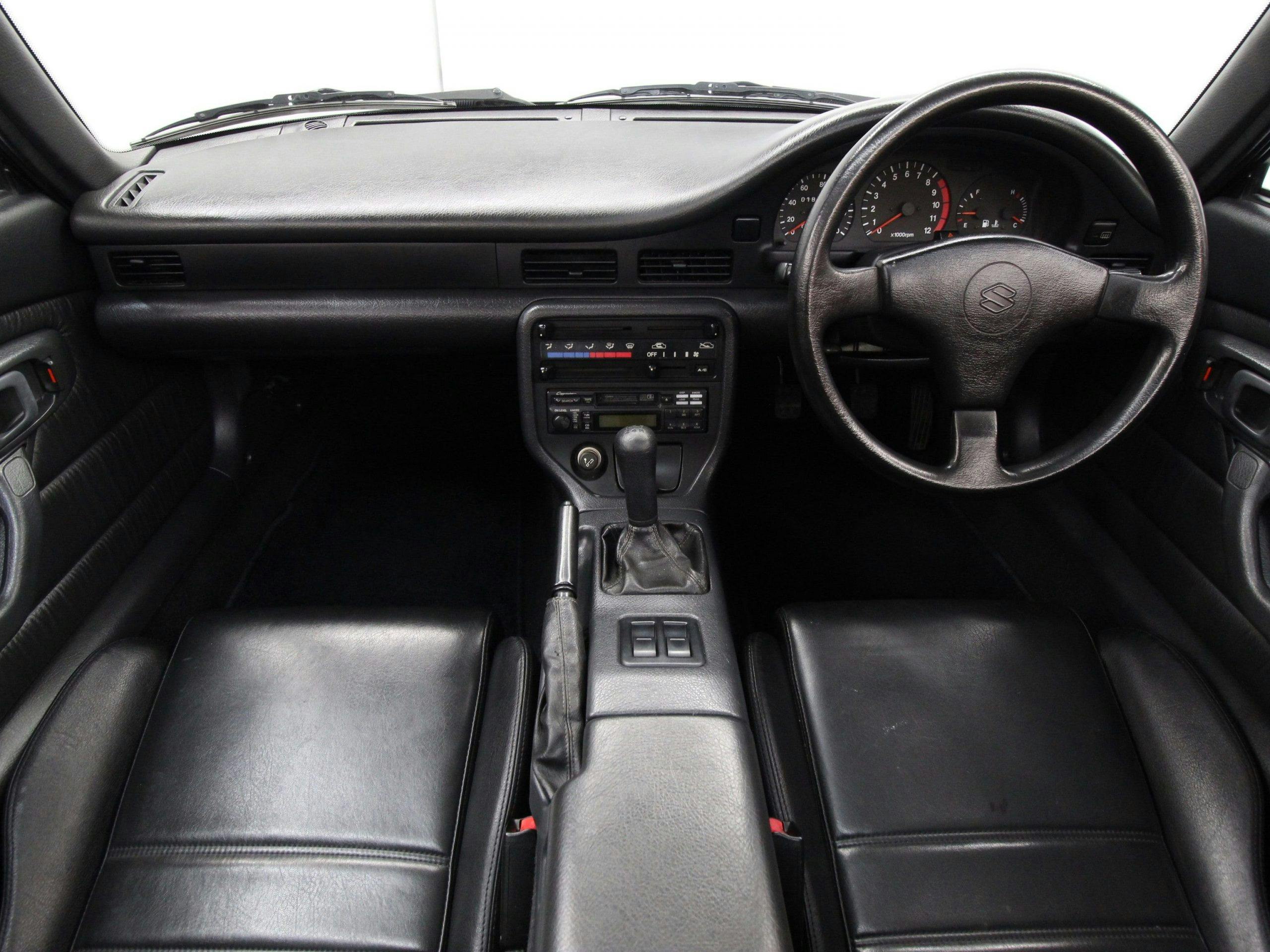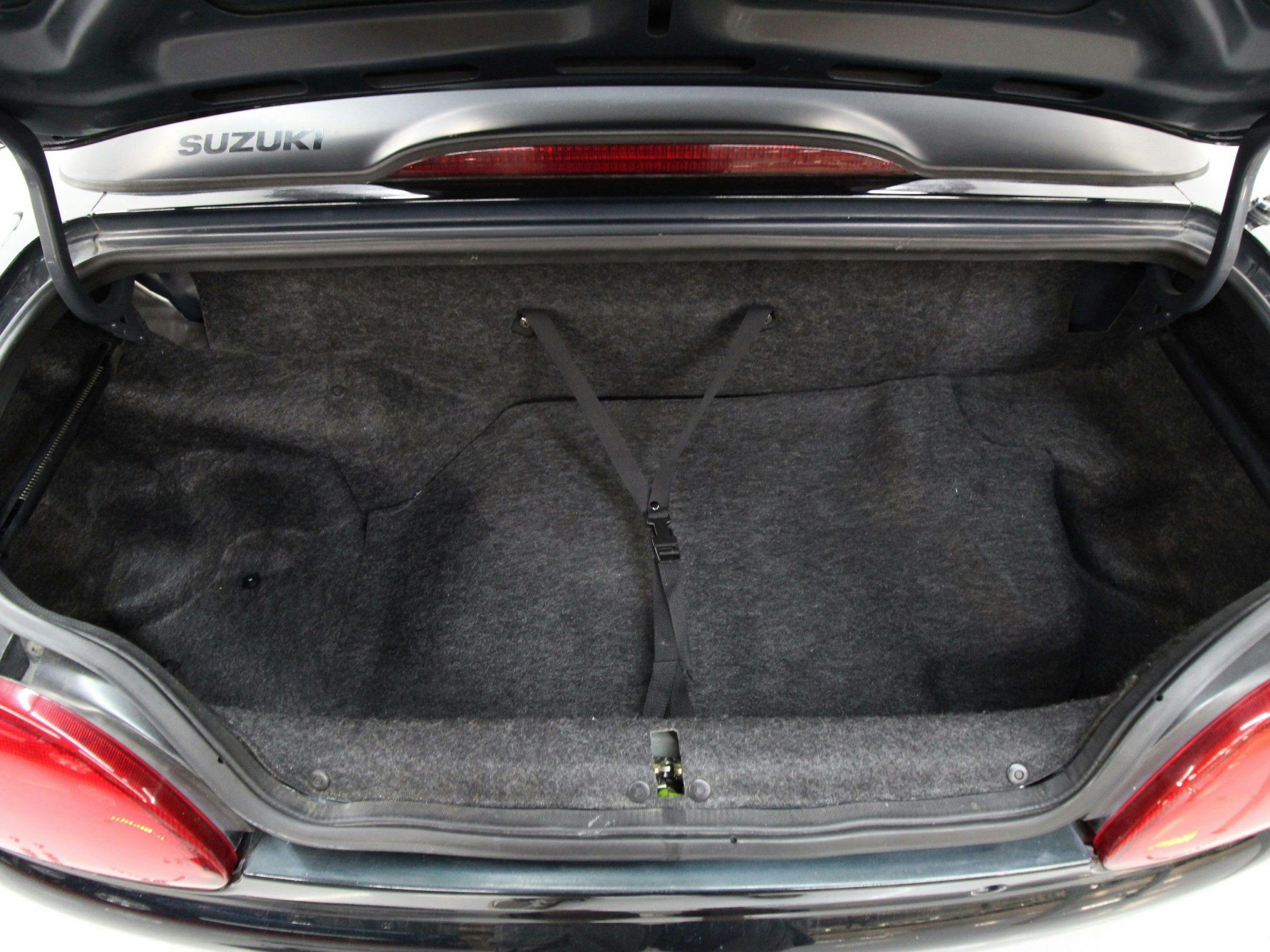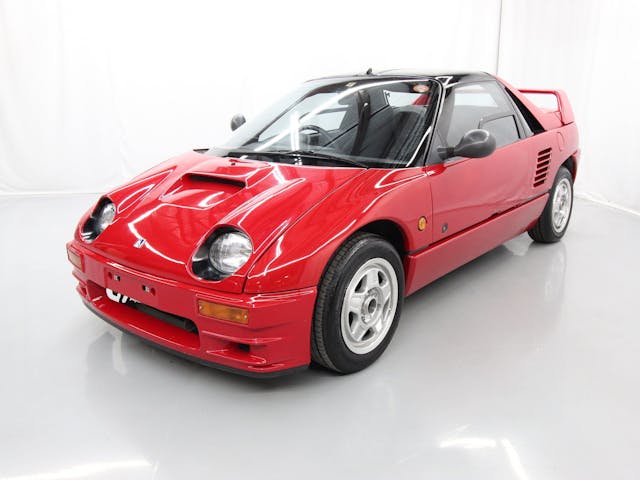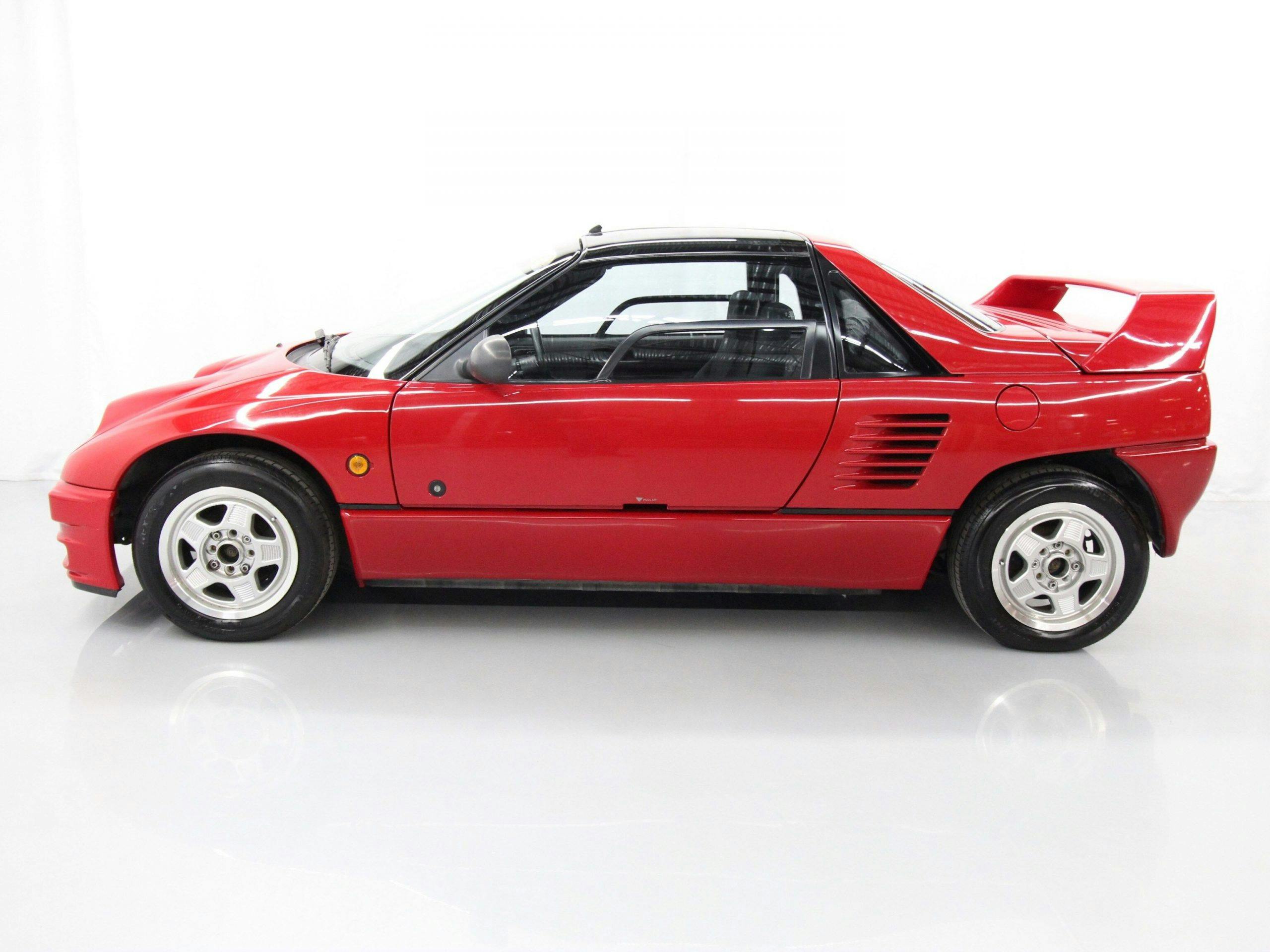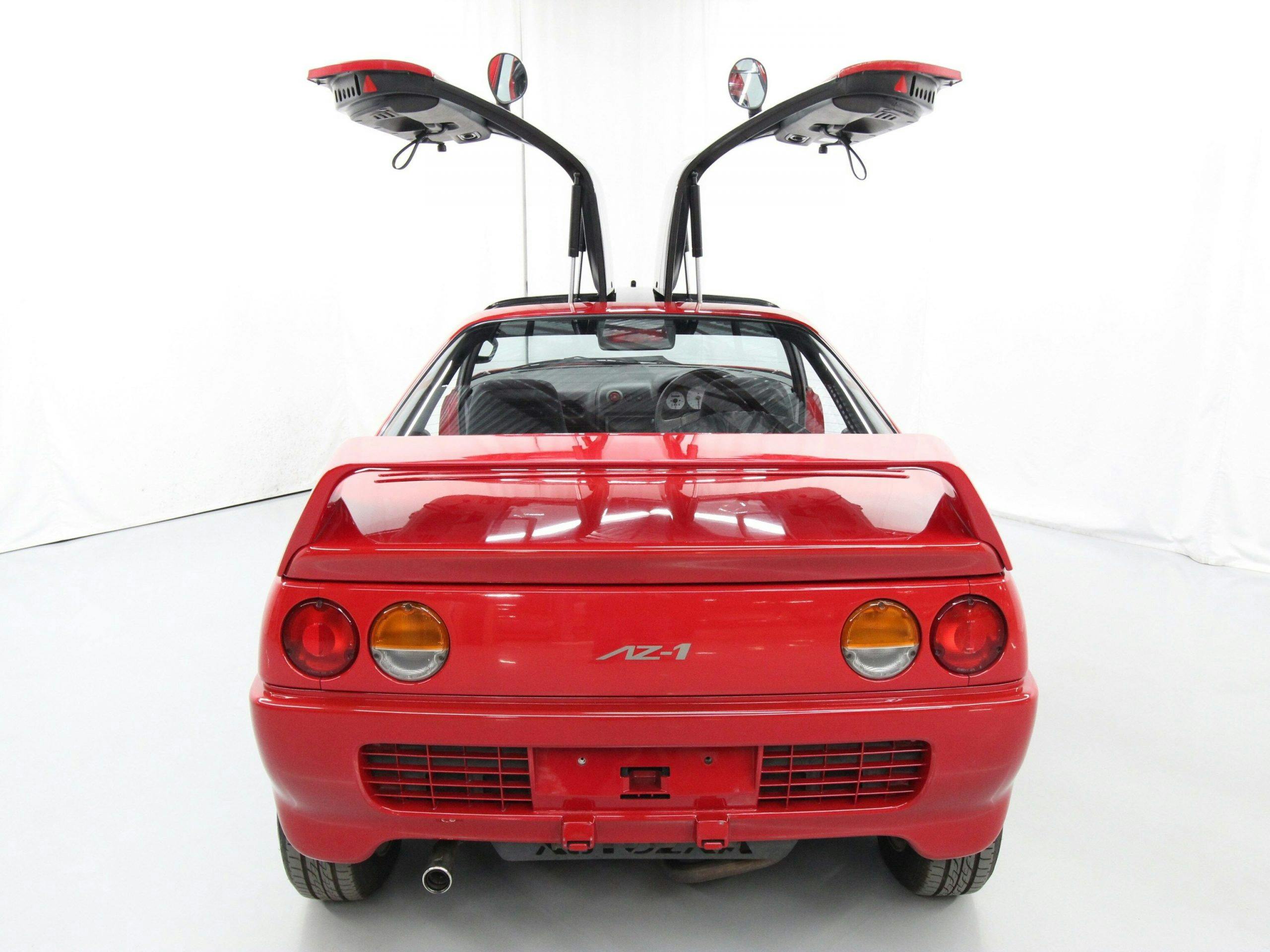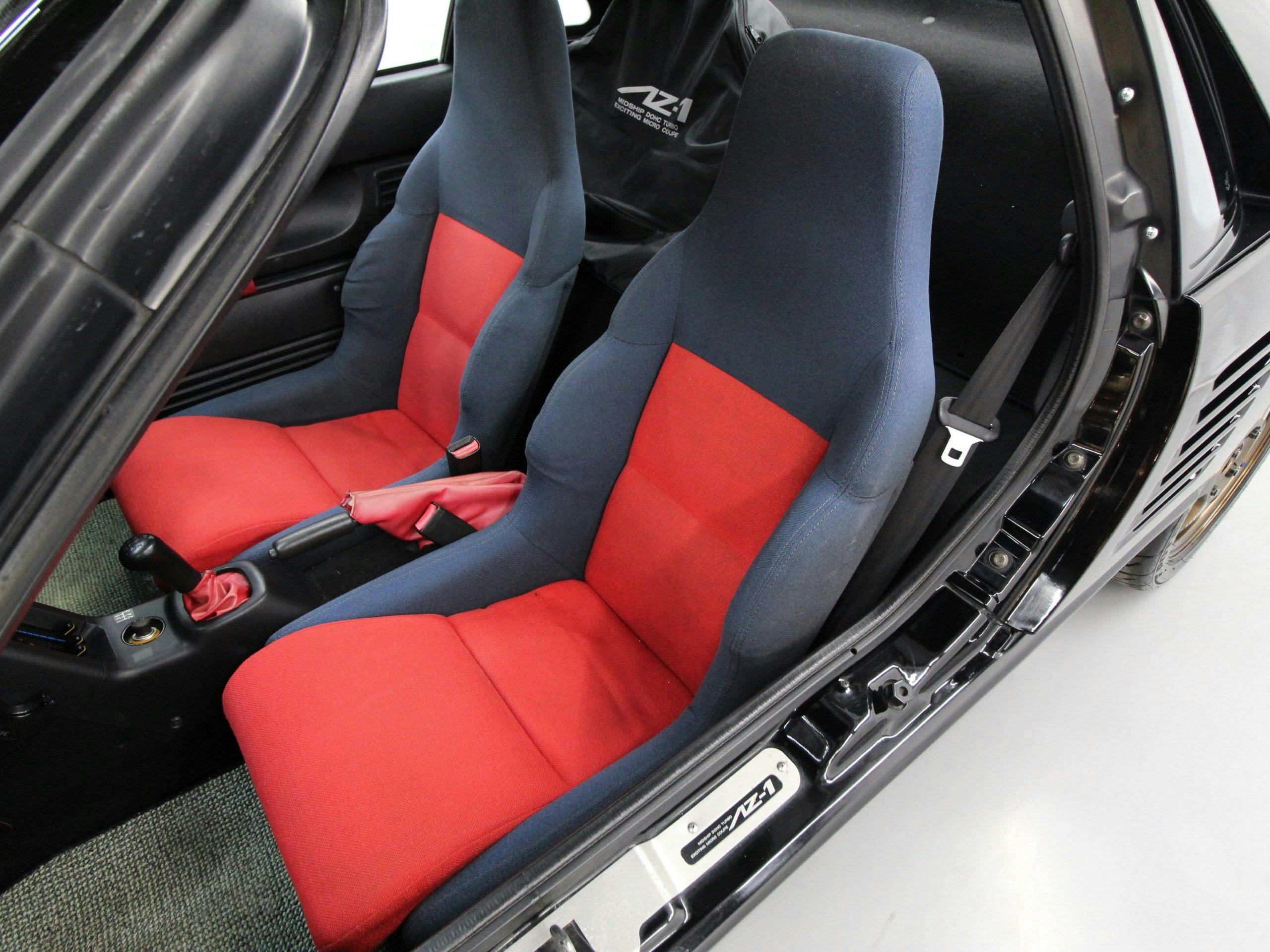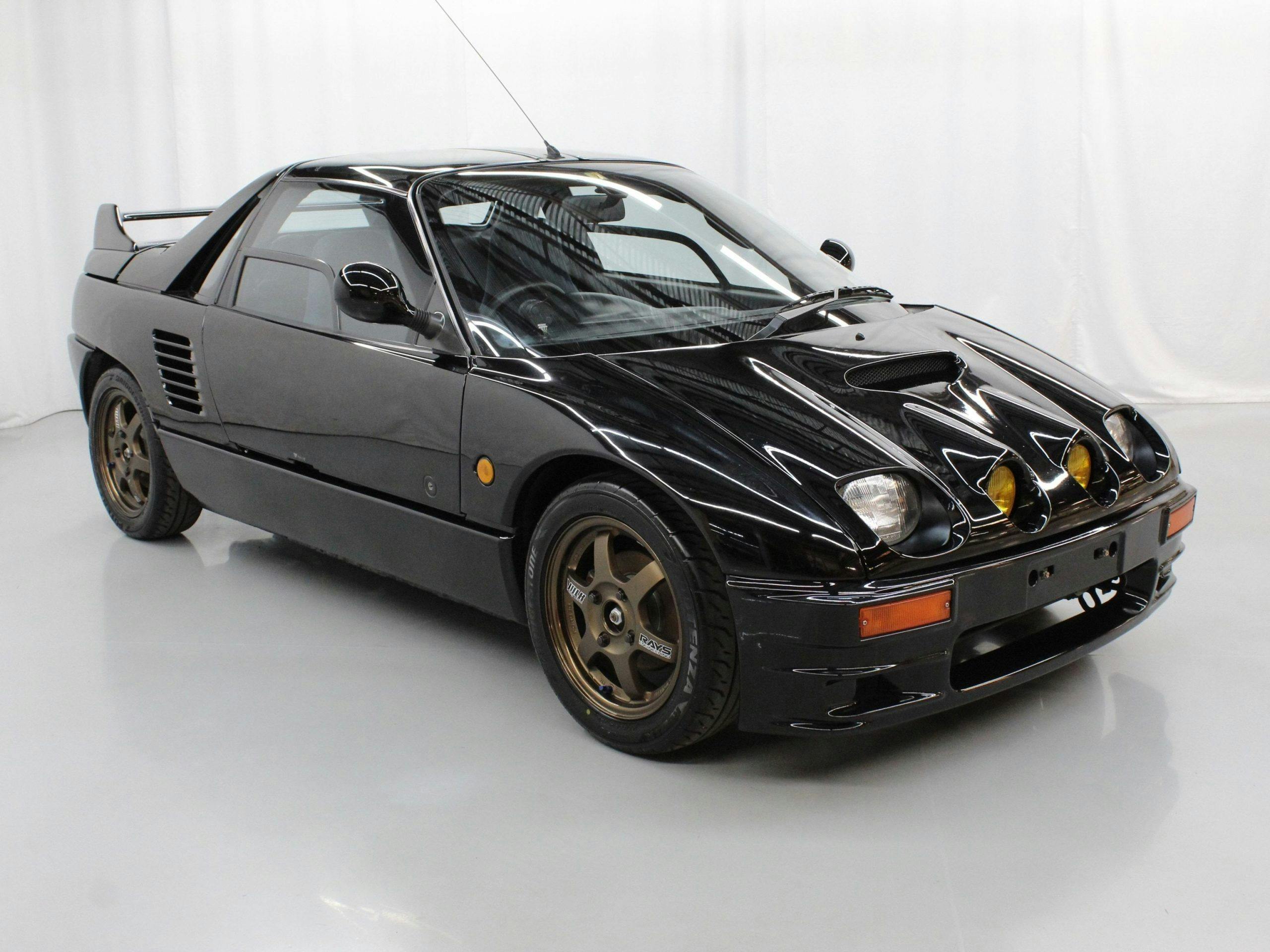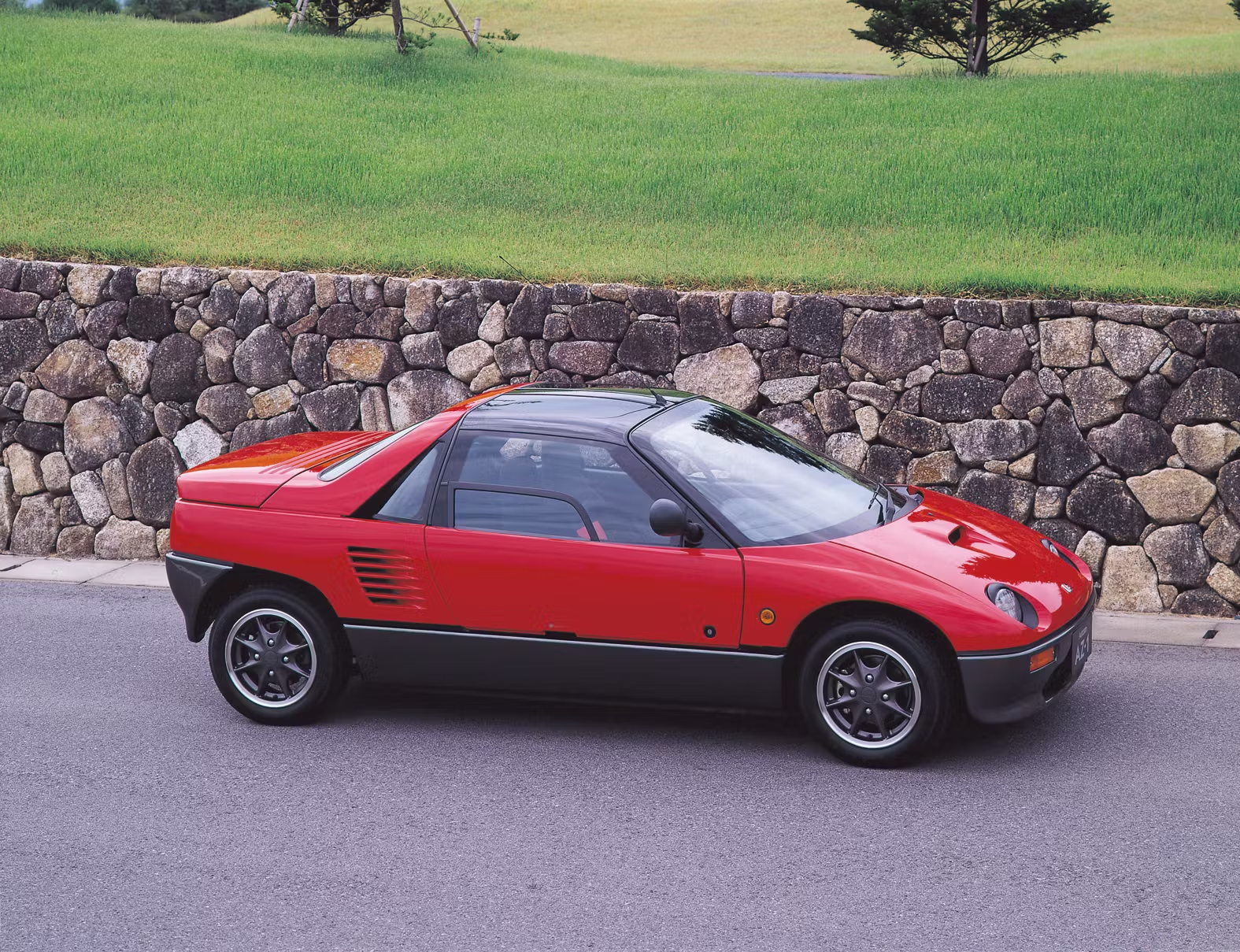Media | Articles
With quirky kei cars, it’s easy as A-B-C
Think of your ideal sports car. If you’re anything like Colin Chapman, low curb weight will be top priority, so let’s shoot for under 2000 pounds. Rear-wheel-drive and a manual transmission are, obviously, a must. Four-wheel independent suspension and a limited-slip differential would be nice. I’m a fan of guilt-free driving; is Prius-level fuel economy out of the question? What about a 9000-rpm redline? Why not go for broke and shoot for a budget under $20,000?
Amazingly, three of these dream cars exist: the Autozam AZ-1, the Honda Beat, and the Suzuki Cappuccino. Otherwise known as the A-B-C kei cars.
So, why hasn’t everyone traded in their Corolla for one of the ABCs? There’s a catch. Even for sports cars, they’re wildly impractical.
Kei cars and the birth of the ABCs
Kei cars are the smallest highway-legal passenger cars in Japan, a land of already small vehicles. To benefit from lower tax and insurance fees, limits are placed on the exterior dimensions and engine size of kei cars. From 1990 to 1998, when the ABC cars were produced, kei cars were limited to 10.8 feet long, 4.6 feet wide, and 6.6 feet high—just barely larger than a golf cart. Think about how small the 2008 Smart ForTwo looks on American roads. To give you an idea, our Smart car was about half-a-foot too wide to be classified as a Kei car.
The kei class has been around since 1949 and very few examples have ever been sold in the U.S. One of the first microcars to cross the Pacific and sell in “big” numbers was the 1958–71 Subaru 360. Starting in 1968, ten thousand of these 900-pound, 25-hp Subarus were imported to the U.S. by Malcolm Bricklin. The 37-second 0-60 time, combined with concerns over its ability to survive a crash against any American car, made buyers think twice about buying it in any significant volume. (Bricklin was obsessed with safety while designing his own car just a few years later.) The Subaru 360 flopped, and it is rumored that unsold units were pushed off barges. One day, someone diving in search of pirate treasure is in for a real head-scratcher.
Marketplace
Buy and sell classics with confidence

In the late 1940s, kei engine displacement was initially capped at 150 cc for four-stroke engines but gradually increased over the years. In 1990, displacement increased for the last time—to 660 cc—and with it came the first official power limit. The Ministry of Transportation anticipated manufacturers were getting too tricky with forced induction and capped output at 63 horsepower. This might not seem like much, but remember these are only 0.66-liter engines; that’s nearly 100 horsepower per liter!
During Japan’s booming late-1980s economy, these three funky little sports cars were developed to take advantage of the bigger engines.
1991-1996 Honda Beat
While the rest of the world was buzzing backroads in pint-sized sports cars, America had to wait until May 2016 to import the earliest of the ABC kei cars: the Honda Beat.
The Beat originated as a Pininfarina design and was the last project approved by company founder Soichiro Honda prior to his passing in 1991. (It was a ceremonial gesture, since he was retired almost two decades earlier.) The Beat was targeted at 1990s Japanese youth, which helps explain the zebra-print seats and floor mats. Maybe you had to be a 20-something in 1990s Tokyo to understand what this Beat commercial meant, because I don’t.
The gauge cluster looks like it was stolen from a motorcycle and is a fitting tribute it the Beat’s very motorcycle-like engine.
The 656cc SOHC inline-three features four valves per cylinder and a MTREC (Multi Throttle Responsive Engine Control) system that continuously modifies the air-fuel ratio of individual cylinders based on engine speed. The three individual throttle bodies, one for each cylinder like in the McLaren F1, gives the Beat sharper throttle response while still maintaining a stable idle.
The Beat’s engine is over-square with a stroke ratio almost as high as a Honda S2000 AP1. Much like the AP1, the 63-horsepower peak hits at a lofty 8100 rpm and what little torque it has lives high in the rev range (44 lb-ft at 7000 rpm). That leaves a very narrow peak power band before the 9000-rpm redline. To accommodate, you’ll find yourself frequently hammering the Beat at full throttle. With an open top, five-speed transmission, and the engine mounted directly behind the driver, who could complain?
All-out speed isn’t everything, of course. The Beat is best on tight backroads. At 1675 pounds it’s the heaviest of the ABCs but still tremendously light. The 90-inch wheelbase is stretched to the corners, leaving overhangs smaller than that of a classic Mini. Four-corner MacPherson struts and a 43/57 rear-weight bias makes turning feel instantaneous. Starting in 1993, the rare Version Z offered optional ABS and a limited-slip differential.
If any cars fits the cliché of handling like a go-kart, it’s the Beat. The overall width is well under 5 feet, which gives the driver more than enough room to hit the apex without leaving their lane.
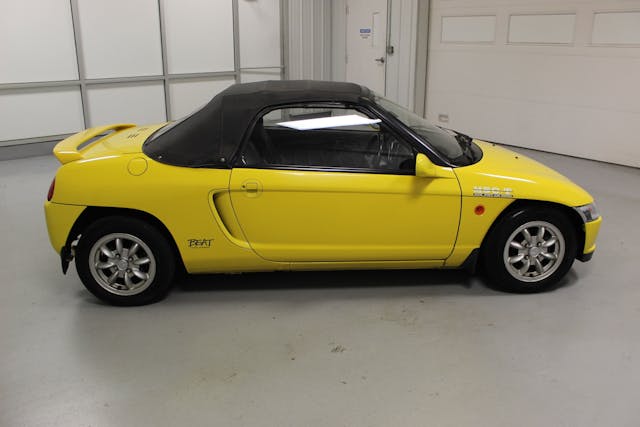
The Beat was an early favorite among JDM microcar enthusiasts in America. Maritime imports for the Beat peaked early, while it was the only ABC car legal for import. As more Cappuccinos and AZ-1s were made available, Beat imports dropped sharply and are now imported less frequently than the Cappuccino, which was produced in similar numbers.
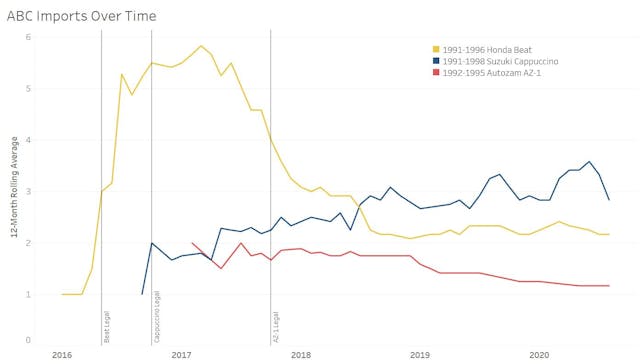
What caused the Beat to lose popularity?
Gary Duncan of Duncan Imports, the largest JDM dealer in the country, has some theories. “Part of it, I think, is the Beats just have no power. But more than anything else, we’re starting to shy away from them because it’s hard to get parts.”
The Beat’s engine was only shared with one other Kei car, the Honda Today, making part availability sparse. To rub salt in the wound, once parts are found, the trunk needs to be removed to access the engine. Even then, it can be hard to reach.
However, these downsides don’t scare the faithful. The Beat has all the ingredients of a classic Honda: supreme handling, perfect shifting, and a high-revving naturally-aspirated engine that makes more power than expected thanks to fancy fuel/air mixing technology. Duncan went on to say, “The Honda badge helps sell. You still got some Beat purist out here.” Beat imports are kept afloat by these Honda fanatics.
Honda built just over 33,600 Beats during a five-year production run, making it the most common of the group; the Suzuki Cappuccino follows with just over 28,000. Expect to pay between $7000 and $9000 for a Beat in good driver condition.
The Honda Beat is a great car on its own, and the decreased popularity might have less to do with its inherent flaws and more to do with the competition.
1991-1998 Suzuki Cappuccino
The Cappuccino became legal in October 2016—just 5 months after the Beat—and is possibly the most under-appreciated of the three. (And my favorite.)
The Suzuki Cappuccino has the most classic sports car layout of the three ABCs. The engine is mounted longitudinally ahead of the driver but behind the front axle, achieving 50/50 weight distribution. Power is sent to the rear wheels through a five-speed transmission. Four-corner multi-link suspension keeps the Capp planted when blasting tight back roads. It’s like a Mazda Miata that was left in the dryer, if that Miata was also turbocharged to a specific output of 100 horsepower per liter.
A Cappuccino in decent condition can be found between $8000 and $10,000. Many ABC buyers will cross-shop the Capp and Beat, since both are convertibles and similarly priced, but the Capp’s engine addresses many of the Beat’s potential issues.
The Suzuki-built “F6A” 657cc DOHC turbo-triple is shared with many Kei cars, so parts are readily available. One of the smallest turbochargers ever in a production car helps the Capp reach the 63-hp limit at 6500 rpm with an even 63 lb-ft of torque at 4000 rpm—a 43 percent increase in torque over the Beat. The increased torque and wider power band make the Cappuccino quicker than the Beat, although it still takes about 10 seconds to reach 60 mph, so we’re really comparing apples to … slower apples. More than anything, the front-engine layout means you don’t need to clear your weekend just to change spark plugs.
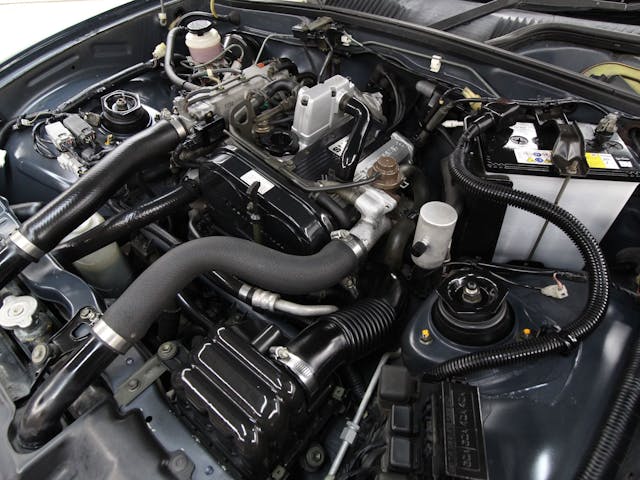
The powertrain isn’t even the best part. The Cappuccino has a hidden parlor trick, in that the three-piece hardtop can be configured as a T-top, targa top, or full convertible with the rear window lowered. When not in use, the roof panels can be stowed conveniently in the trunk.
Even with the added complexity, the Capp is nearly 100 pounds lighter than the Beat, thanks to aluminum in much of its construction. At one point, it even had an aluminum engine. In 1995, the Capp was given the new all-aluminum “K6A” engine in a mid-model revision dubbed the EA21R. The new chain-driven DOHC turbo-three increased torque to 76 lb-ft at a lower 3500 rpm, making the little Cappuccino even sportier. These later Cappuccinos also saw an optional three-speed automatic and an early iteration of speed-sensing electric power steering. Post-revision EA21R Cappuccinos are legal for import starting earlier this year. If you plan on modifying a Cappuccino, stick with the “F6A” engine as it can hold up to greater modifications. With a little turbo tuning, you could be driving this:
The Cappuccino was the only ABC car to be sold new outside of Japan. Shortly after the car’s release, Suzuki Great Brtain thought the little convertible would be a hit in the land of impractical, small convertibles. However, it wasn’t quite the success the Brits had hoped, and only 1182 Capps were sent their way. One easy way to spot the difference between British and Japanese Cappuccinos is to look at the side indicators: they are flush with the body on the JDM model.
The Cappuccino is often regarded as the most comfortable and practical of the three. The “large” trunk makes it the only ABC you could use to get groceries. It’s an all around great car, and with production numbers almost as high as the Beat, it’s clear why the Capp has lead ABC imports the last two years.
A 1600-pound car three-fourths the size of a Miata isn’t exotic enough for you? What if it had gull-wing doors?
1992-1994 Autozam AZ-1
For most ABC fans, the Autozam AZ-1 is the car to have. Just look at it! It’s like a Micro Machines Ferrari F40.
The main attraction of the AZ-1 is the gull-wing doors, one of the only dozen or so cars to ever have them. When an AZ-1 is parked, doors up, at a car meet it pulls all the attention away from exotics at one-tenth the price.
If you’re unfamiliar with Autozam, it was an affordable sub-brand of Mazda aimed at youth, kind of like Scion was to Toyota. The AZ-1’s Mazda connection runs deep. Toshiko Hirai was selected to lead the project shortly after his team finished the NA Miata. There is even a Mazdaspeed AZ-1.
The AZ-1 checks all the supercar boxes; mid-engine, rear-wheel-drive, crazy doors, functional side vents, four wheel independent suspension, and absolutely no practicality. Unlike the Beat and Cappuccino, there is no trunk. There might be room for an overnight bag behind the seats but it will have to compete with the spare tire, which was originally stored in the “frunk” but moved inside the cabin due to safety concerns.
The AZ-1 has the most cramped passenger compartment of the ABCs. and since there is no open top to relieve claustrophobia, you should try one on before you buy. The 5’11” Jay Leno managed to fit no problem, but he doesn’t look very comfortable.
Really, all the ABC cars are impractical. So, if you are going to get one, why not get the craziest?
Even though it looks like the AZ-1 would be hard to live with, there’s a few things that makes it more manageable than the Honda Beat, its mid-engine competitor. The AZ-1 shares it’s “F6A” turbo-three with the Suzuki Cappuccino, making part availability much better while also solving the Beat’s power issue. An open engine compartment and access panels behind the seats make maintenance a relative breeze.

As expected, output is the same as the Cappuccino: 63 horsepower and 63 lb-ft of torque. At only 1587 pounds, ten pounds lighter than the Cappuccino, the AZ-1 is the lightest of the three. Weight is kept down using fiber-reinforced plastic body panels which won’t rust—a common issue with Beats. When pitted against the Cappuccino, the AZ-1 is quicker around a track, though it was in the hands of “Drift King” Keiichi Tsuchiya:
Sounds amazing, right? So, why haven’t AZ-1 imports increased like the Cappuccino? The answer lies in the production numbers.
Like your author at a party where nobody likes cars, the AZ-1 was the last to arrive and the first to leave. Autozam began production in October 1992, and by 1994 it was gone. The AZ-1 was born at the wrong time. As the Cappuccino and Beat benefited from starting sales before Japan’s “Lost Decade” economic crisis, the AZ-1 hit showrooms right as the recession was in full swing. Suddenly, the wildly impractical AZ-1 seemed like a poor choice when a Miata was just a few yen more. Like the BMW 507, it was too expensive and considered a sales flop in its time.
AZ-1 sales fell far below its 800 per month target and Mazda quickly pulled the plug. Only 4392 AZ-1s were produced, with an additional 531 of the rebadged Suzuki Cara. To help move unsold units, Mazda introduced a couple of special editions.
Around 100 Mazdaspeed AZ-1s were produced which featured a more aggressive hood, front spoiler, and rear wing. All Mazdaspeeds have full red or blue paint jobs; base models are red or blue with grey lower cladding. The handling is improved with a mechanical limited-slip-differential, sportier suspension, front and rear strut bars, and alloy wheels. The powertrain is left mostly stock with the exception of an upgraded air filter and stainless/ceramic muffler.
The 1015 was built by Mazda subsidiary M2 and is the rarest AZ-1. It features a revised front bumper and rear wing, but most notably adds front fog lamps into the hood making the AZ-1 resemble a mini Group B car. Like the Mazdaspeed, they are all one color : white, black, or silver. M2 originally planned to build 50 for the 1994 model year but only sold about 25. The remaining parts were sold individually to cover the brand’s loses.
Rarity often determines value, but more than anything the AZ-1 is just so damn cool. For the price of an AZ-1, you could buy both a Beat and a Cappuccino. A good-condition AZ-1 can be picked up for $15,000 to $20,000, with Mazdaspeed and M2 1015 special editions selling at the top of that range.
Where did the kei sports cars go?
Unfortunately, this was the heyday of the sporty kei car, a segment that was ultimately killed by Japan’s “Lost Decade.” The ABC kei cars have not been lost to time, though. They’ve always had a cult following in Japan, and the excitement has spread to America.
Duncan thinks cars like this are the future. “These automobiles are generational and I’m watching it. I never thought a ‘40 Ford would go down in value because it was ‘the bootlegger’s choice’ and now they are. 1950s cars are going down, too. Now, I’m betting the farm on ’80s-plus models because that’s the generation that’s coming.”
He’s not wrong.
Using Hagerty insurance quotes as a sign of buying interest, the median age of an ABC kei car buyer is 31, which bodes well for future collectibility. In fact, millennials make up 65 percent of ABC quotes. It’s likely there will be a strong market for obscure Japanese cars for years to come. I can see Gen Z taking to these cars, too.
One of the only Kei sports cars made after the 1990s is next on Duncan’s list. When asked about what future imports he’s looking forward to, he said “First thing is going to be a V12 [Toyota] Century. After that, the Daihatsu Copen.” The V12 Century will be legal in 2022, but we’ll have to wait until 2027 for the first-generation Copen.
A spiritual successor to the Beat, the Honda S660, is currently in production and looks amazing. Americans are forced to wait until 2040 to import them. Personally, I can’t wait until the current Suzuki Jimny is legal, but I’ll have grey hair by then.
